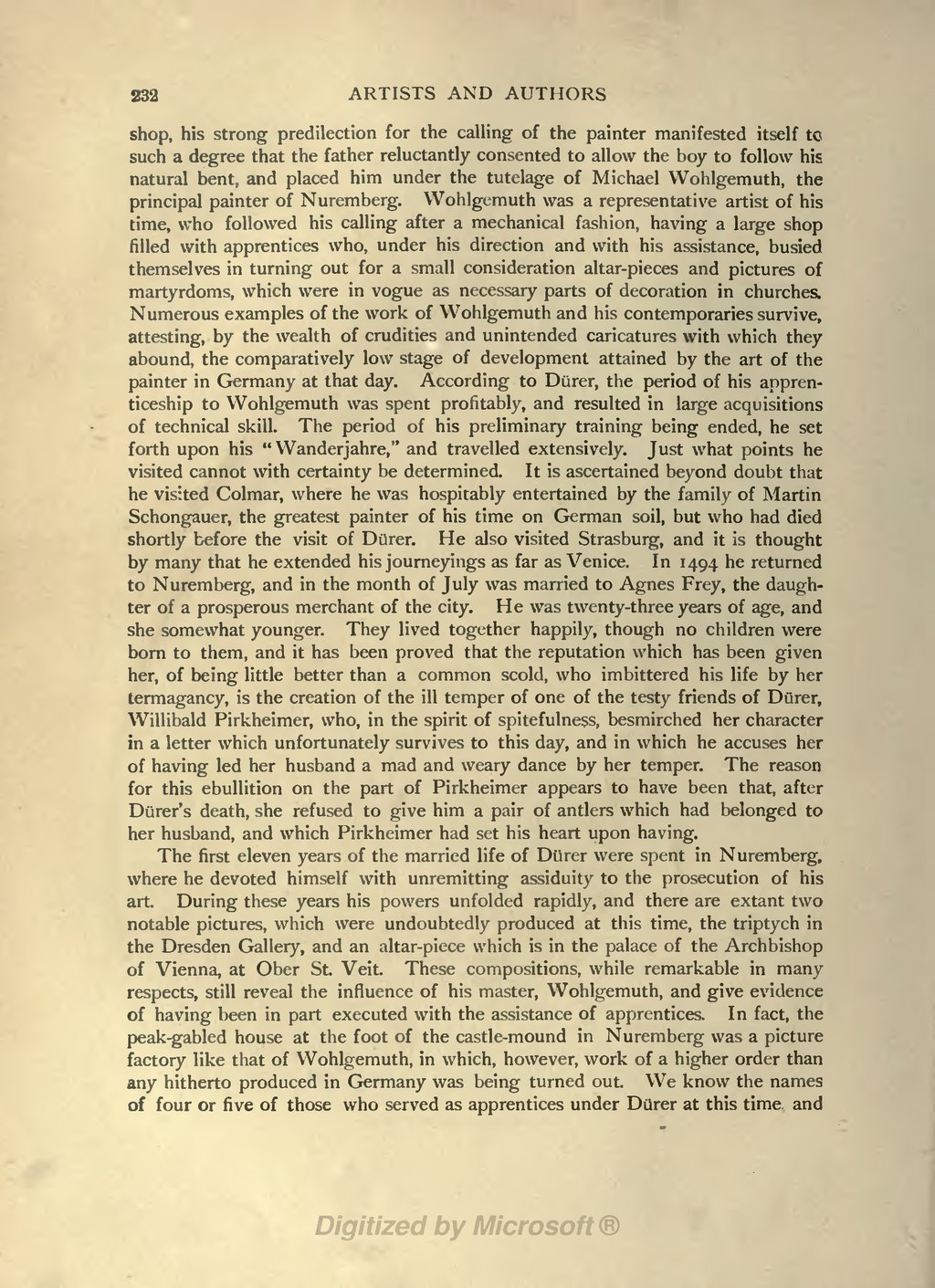232 ARTISTS AND AUTHORS shop, his strong predilection for the calling of the painter manifested itself to such a degree that the father reluctantly consented to allow the boy to follow his natural bent, and placed him under the tutelage of Michael Wohlgemuth, the principal painter of Nuremberg. Wohlgemuth was a representative artist of his time, who followed his calling after a mechanical fashion, having a large shop filled with apprentices who, under his direction and with his assistance, busied themselves in turning out for a small consideration altar-pieces and pictures of martyrdoms, which were in vogue as necessary parts of decoration in churches. Numerous examples of the work of Wohlgemuth and his contemporaries survive, attesting, by the wealth of crudities and unintended caricatures with which they abound, the comparatively low stage of development attained by the art of the painter in Germany at that day. According to Durer, the period of his appren- ticeship to Wohlgemuth was spent profitably, and resulted in large acquisitions of technical skill. The period of his preliminary training being ended, he set forth upon his " Wanderjahre," and travelled extensively. Just what points he visited cannot with certainty be determined. It is ascertained beyond doubt that he visited Colmar, where he was hospitably entertained by the family of Martin Schongauer, the greatest painter of his time on German soil, but who had died shortly before the visit of Durer. He also visited Strasburg, and it is thought by many that he extended his journeyings as far as Venice. In 1494 he returned to Nuremberg, and in the month of July was married to Agnes Frey, the daugh- ter of a prosperous merchant of the city. He was twenty-three years of age, and she somewhat younger. They lived together happily, though no children were born to them, and it has been proved that the reputation which has been given her, of being little better than a common scold, who imbittered his life by her termagancy, is the creation of the ill temper of one of the testy friends of Durer, Willibald Pirkheimer, who, in the spirit of spitefulness, besmirched her character in a letter which unfortunately survives to this day, and in which he accuses her of having led her husband a mad and weary dance by her temper. The reason for this ebullition on the part of Pirkheimer appears to have been that, after Diirer's death, she refused to give him a pair of antlers which had belonged to her husband, and which Pirkheimer had set his heart upon having. The first eleven years of the married life of Durer were spent in Nuremberg, where he devoted himself with unremitting assiduity to the prosecution of his art. During these years his powers unfolded rapidly, and there are extant two notable pictures, which were undoubtedly produced at this time, the triptych in the Dresden Gallery, and an altar-piece which is in the palace of the Archbishop of Vienna, at Ober St. Veit. These compositions, while remarkable in many respects, still reveal the influence of his master, Wohlgemuth, and give evidence of having been in part executed with the assistance of apprentices. In fact, the peak-gabled house at the foot of the castle-mound in Nuremberg was a picture factory like that of Wohlgemuth, in which, however, work of a higher order than any hitherto produced in Germany was being turned out. We know the names of four or five of those who served as apprentices under Durer at this time and
